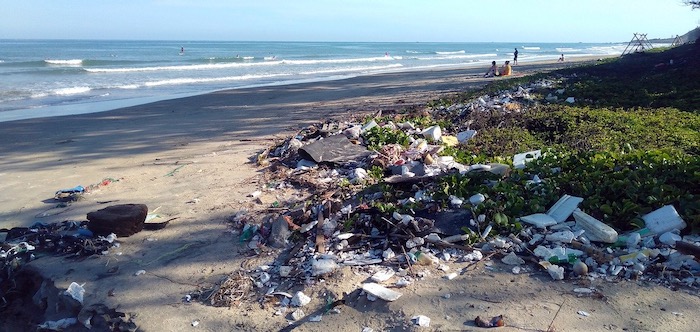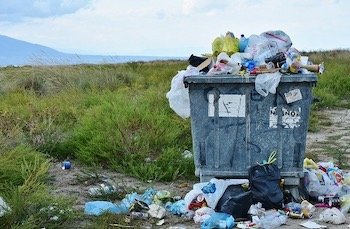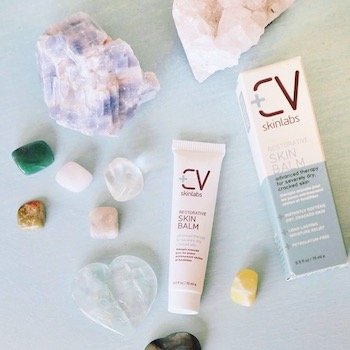
Which cosmetic ingredients are bad for the environment?
Though the beauty industry has made progress when it comes to using safe and non-toxic ingredients, there are still a few out there that you’ll want to avoid if possible.
Just like other products we use in our modern-day lives, cosmetics are negatively affecting our environment. Many of these products contain plasticizers, surfactants, and chemicals linked to toxic effects on humans and the environment.
We wash these products down the drain or dispose of them in the trash, which means the toxins in the products and the packaging can get into our waterways and eco-systems where they can harm wildlife, and potentially come back to harm us too.
Below, we list some of the most damaging ingredients that you may still find in your cosmetics. You can read labels to avoid them in many cases, though in some instances the ingredients are by-products so they won’t show up on the label.
Buying from reputable companies—like CV Skinlabs!—that use only safe ingredients is another good way to protect yourself and the planet.
8 Cosmetic Ingredients that are Bad for the Environment
1. Chemical Sunscreens
Sunscreens like oxybenzone and octinoxate have been found to have a damaging effect on coral reefs. When they are flushed away into the water, they end up in coral reefs where they increase vulnerability to bleaching and prevent coral growth.
In a 2016 study, a team of international scientists found that oxybenzone enters the environment through wastewater and directly from swimmers wearing sunscreens. There, it creates four toxic effects, including DNA damage and gross deformities of baby coral. The authors of the study concluded that sunscreen alternatives could protect coral reefs.
These ingredients appear on the product label. We suggest using zinc or titanium dioxide, which are not only safer for the environment but for you as well.
Cosmetic Ingredients Bad for the Environment #2. Triclosan
This antibacterial agent is a popular ingredient when it comes to avoiding germs, but it has been found to harm algae and marine life. The FDA has also banned its use in antiseptic washes because it may increase the prevalence of antibiotic-resistant bacteria.
You can find this ingredient on the label. Look for triclosan-free soaps, sanitizers, and toothpaste.
3. Parabens
This ingredient, though it has decreased in recent years, is still found in some cosmetics. A preservative, it has been linked to cancer in some studies and has been found in the tissues of marine mammals like dolphins, sea otters, and polar bears.
The Environmental Working Group (EWG) also reports that these chemicals may cause reproductive issues in animals and kill coral reefs.
You can find this ingredient on the labels of some lotions, shampoos and conditioners, makeup, shaving gels, deodorants, and more. Look for words like propylparaben, isopropylparaben, butylparaben, and isobutylparaben.
Cosmetic Ingredients Bad for the Environment #4. Chemical Fragrances
Stanford University reported in 2004 that household fragrances may be harming aquatic wildlife.
They tested chemical fragrances found in soaps, shampoos, deodorants, detergents, and other similar products on California mussels. They noted that these synthetic fragrances can get into the environment through sewers and drains.
In their study, the fragrances compromised the mussels’ ability to defend themselves, meaning that any future exposure to chemicals would be even more damaging to them. Humans could be similarly affected, in that exposure to chemical fragrances could make it easier for pollutants to enter the brain.
You can avoid synthetic fragrances by reading labels. If you see the word “fragrance” without an explanation, that means that an unknown number of chemicals may have been used to create the smell. Look for fragrance-free products or those that use natural ingredients like essential oils to create a pleasant scent.
 5. Plastics
5. Plastics
National Geographic reports that the amount of plastic packaging in U.S. products has increased by over 120 times since 1960, with almost 70 percent of that waste piling up in landfills.
The Environmental Protection Agency (EPA) notes that containers and packaging amounted to 82.2 million tons of solid waste in 2018. Meanwhile, about 8 million tons of plastic enter the ocean each year, and cosmetic containers contribute a great amount to that total.
Millions of fish and birds die from the complications of plastic being in and around the sea, but humans are at risk too. Plastic microfibers have been found in tap water and over 100 aquatic species consumed by humans.
Many beauty brands are taking notice of the issue, and working to make their packaging more sustainable. Here at CV Skinlabs, we use bottles and tubes that are recyclable, BPA/BPS-free and PFAS-free. We also print our product information on the inside of the boxes, to save resources, and are working towards utilizing post-consumer recycled materials as they become more readily available.
Our recycle codes are visible on our bottles, but it can be hard to determine whether you can recycle other beauty product packages. Your best approach is to research the company and find out whether they care about creating sustainable packaging.
You can also limit your use of single-use products, and look for packages you can refill and reuse.
Cosmetics Ingredients Bad for the Environment #6. BHT and BHA
These are popular preservatives often used in moisturizers, makeup, body lotions, deodorants, and shampoos. They are suspected of being hormone disruptors, but they are also linked to environmental harm.
They can cause genetic mutations in amphibians, for example, and can alter behavior and even cause death in fish and shellfish. You can see these on the label, so all you have to do is avoid products that use them.
7. Dibutyl Phthalate (DBP)
This is a plasticizing chemical—one of a class of chemicals called “phthalates.” You may find it in nail polishes to prevent them from becoming brittle, as well as in some hairsprays and insect repellants.
DBP can get into the environment when nail polish is removed and discarded down the drain or into the trash. It accumulates in the environment and affects a wide variety of aquatic species. As it builds up, it may alter behavior, genetics, growth, and reproduction.
You can find DBP on the label as one of the following ingredients:
- 1,2 benzenedicarboxylic acid
- DBP (ester) or dibutyl ester
- Butyl phthalate
- 1,2-benzenedicarboxylate
There may be other variations on these names as well, including celluflex DBP. Manufacturers may use it as a fragrance ingredient. If so, you probably won’t see it listed, but will see only “fragrance” instead.
8. Per- and Polyfluoroalkyl Substances (PFAS)
PFAS are a toxic class of chemicals found in everything from nonstick cookware to carpets to firefighting foams. Investigators have found some PFAS to contaminate drinking water in many locations around the country. Studies have linked them to an increased risk of health issues including high cholesterol, high blood pressure, low birthweight, and cancer.
PFAS may also be found in cosmetics. Manufacturers sometimes add them to increase the durability and water-resistance of the product. In a recent study, scientists analyzed 231 cosmetic products—including concealers, eye makeup, foundations, lip color, and mascara—for fluorine, a marker of PFAS.
Overall, 52 percent of these products had high levels of fluorine, suggesting that the cosmetics contained high levels of PFAS. Mascaras, foundations, and liquid lipsticks were the most likely to have higher levels.
The results of this study prompted legislators to introduce a “No PFAS in Cosmetics” Act to ban PFAS completely from personal care products. It remains to be seen whether the legislation will pass.
Unfortunately, there is no way to tell currently whether your product has these chemicals or not. To try to reduce your exposure, limit how much makeup you use and how often you use it. Also, consider removing it as soon as you get home, or wipe off lip products before eating.
 CV Skinlabs’ Commitment to Avoiding Cosmetics that are Bad for the Environment
CV Skinlabs’ Commitment to Avoiding Cosmetics that are Bad for the Environment
We’re happy to report that at CV Skinlabs, we have been conscious of toxic ingredients from the beginning. When we were creating our products, we made sure to avoid all ingredients with toxic effects against humans or the environment.
Then we took extra steps to make our packaging recyclable and to minimize the resources used to create it.
But we didn’t stop there. Our work with sustainability is ever evolving. We regularly review our sustainability practices so that we can continue to reduce our impact on the environment.
You can feel good about using our products, knowing that they’re safe for everyone in the family as well as for the environment.
Do you avoid cosmetics that are bad for the environment?

